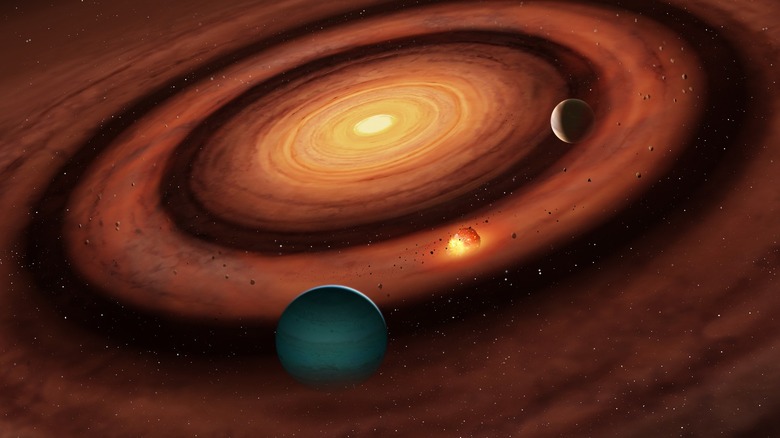New Sandwiched Planet Formation Theory Could Explain How Smaller Planets Evolved
When it comes to explaining how planets are formed, the protoplanetary hypothesis is the most widely accepted explanation. In simple terms, the donut-shaped disc of dust and gas around a star forms the building block of planets. These particles clump together over time, like a snowball, to form larger celestial bodies like planets, a process that can take millions of years.
Now, scientists at the University of Warwick claim to have discovered a new method of planet formation that says two larger planets in the protoplanetary disc of a star can lead to the creation of a smaller planet between them. The team is calling it the "sandwich" theory and their findings have been published in the Monthly Notices of the Royal Astronomical Society journal.
While the mechanics of how exactly sandwich planet formation happens requires further research, it answers one crucial piece of the cosmic puzzle. "This theory could present a possible explanation for the formation of small planets, like Mars and Uranus, which are each surrounded by larger planets," says the team.
The "sandwiched planet formation" theory offers a rather unique perspective on planetary genesis with respect to their size and geological chemistry. But there are a few oddities that evade even the new theory. In 2020, scientists spotted an exoplanet named K2-25b in the Hyades cluster that is unusually dense and defies conventional theories about planet formation.
Precedent in our own backyard
The protoplanetary theory says larger gas giants — like Saturn and Jupiter — are formed first due to the availability of gaseous raw material. And they are usually further away from their host star, while smaller and rocky planets like Venus are formed closer to the Sun.
The new theory put forth by University of Warwick scientists says that there are rings and gaps in protoplanetary discs, and it's in these rings where sandwiched planet formation occurs. Between two giant planets in a disc, the flow of dust is restricted. But if that dust somehow manages to escape, it leads to the creation of a smaller, middle planet between the two larger siblings.
"The gaps are where we expect planets to be, and we know from theory work that planets cause dust rings to form just exterior to them," explains Farzana Meru, an associate professor at the University of Warwick's physics department. Notably, the researchers say they have actually found evidence of planetary architecture that supports the sandwiched formation theory.
The team says there are examples out there where a smaller planet sitting between two larger planets in a solar system, and their proportions also check out. More importantly, researchers claim that the sandwich theory could very well explain the formation of Mars and Uranus, both of which are flanked by larger planets on each side. While further research is needed, it's an exciting new breakthrough that could unravel a new cosmic process right in the Earth's own solar backyard.
